by Heather Plett | Nov 5, 2012 | change, Community, Creativity, journey, Leadership, Passion

sharing stories and stitching prayer flags at a recent women's gathering
I talk a lot about stories – how important they are in helping us find collective healing, how transformative they can be in encouraging us to dream of a new world, how much they connect us to each other and give us courage.
“But what IS a story?” the students in my Creative Writing for Self-Discovery class pushed back a few weeks ago. “How do you define it? You’ve made reference to the story arc and conflict and plot, but we still don’t know the ‘rules’. How do we figure out whether or not something we write fits the definition of story?”
“Next week,” I promised, and then went home and started brushing up on my definition of story.
When I incorporate storytelling into leadership and personal growth workshops, I purposely leave my definition fairly vague. “A story is simply your account of how things happened. It can be as simple as helping people see a new possibility by telling them ‘when Jim did this last week, it made his daily routine much easier.'” But this was different. This was a group of creative writers who want to master the craft of writing short stories – whether simply for their own enjoyment or for the possibility of getting them published some day.
I did what any teacher would do – I went back to the tried and true definitions from back when I was getting my English degree. I typed up a lovely list of story elements for my students – setting, plot, conflict, character, point of view, and theme. I found a helpful diagram of the story arc that demonstrates how a story moves from routine, through the inciting incident that changes everything, through rising tension, to the climax, and ultimately to the denouement (resolution). I defined the protagonist as the main character and the antagonist as whatever source of conflict arises from the inciting incident which the protagonist must conquer before there is resolution. As I prepared my notes, I had flashbacks of my literature professors (all aging white men, incidentally) drilling it into our impressionable mines that “unless there is conflict and some kind of climax and resolution, THERE IS NO STORY!”
It was all good material that my professors would have been proud of… BUT… it didn’t entirely satisfy me. Something was wrong. Even though it was the kind of handout that would have gotten me an A in my university literature classes, the twenty plus years of wisdom I’ve gained since didn’t quite jive.
Then, while reading A Passion for Narrative, something jumped out and shook me out of my complacent regurgitation. You could say that it was my “inciting incident” where everything changed. It was this quote from Janet Burroway:
“Seeing the world in terms of enemies and warring factions not only limits the possibilities of literature, but also promulgates an aggressive and antagonistic view of our own lives. Further, the notion of resolution is untrue to life, and holds up perfection, unity, and singularity as goals at the expense of acceptance, nuance, and variety… Birth presents us with an alternative model in which there is a desired result, drama, struggle, and outcome. But it also represents a process in which the struggle, one toward life and growth, is natural. There is no enemy. The “resolution” suggests continuance rather than finality. It is persuasively argued that the story as power struggle offers a patriarchal view of the world, and that it would improve both stories and world if we would envision human beings as engaged in a struggle toward life.”
WAIT JUST ONE MINUTE! There’s a different way of defining stories? There doesn’t need to be a protagonist and an antagonist and the struggle doesn’t need to be AGAINST someone or something?
Something new in me woke up. Perhaps more truthfully, something old and primal in me was re-awakened. Suddenly it all made sense, and my storytelling wisdom lined up with my exploration of feminine wisdom.
We’ve been telling too many patriarchal stories! We’ve been letting our old white male university professors convince us that that’s the way it HAS to be! We’ve been conditioned to believe that our stories are not real stories unless there is an evil force to overcome. We’ve sat through hundreds of movies, read thousands of books, and listened to a million children’s stories that have all lead us to believe that there is conflict that needs to be overcome and that the only way to wrap up the story is to tie up the loose ends into some kind of (usually artificially constructed) resolution.
We don’t have to tell those kinds of stories anymore. In fact, the world needs us to start telling NEW stories – ones that are modelled on birth, where there is still a struggle, but this time we are struggling TOGETHER to bring about something new. There is no enemy. And the endings don’t need to be resolved, but rather they leave us at a place of continuance, growth, or just a whole lot of new questions for us to sit with.
This is so much bigger than simply a Tuesday evening creative writing class. This new way of engaging with story is about a new way of engaging with our economy, our religions, our communities, and our earth. It doesn’t have to be about competition anymore. There doesn’t have to be an antagonist in our stories. We can all be protagonists in the struggle together, birthing something new and ending not with a resolution, but with a step into the next story.
It all made sense to me when I read that quote, because THIS is what I feel most called to bring to the world – a new way of telling stories, a new way of walking through struggle, a new way of engaging with each other, and a new way of sensing the future. This is a new story that is actually more like an old story finally being reborn. Patriarchy does not have to rule us anymore. The old stories don’t have to control the way we see the world. We can usher in the Feminine. We can “shake the world with a new dream“. We can redefine ourselves as artists. We can build a new sacred economy. We can lead with our wild hearts.
It’s not easy letting go of the old stories. We’ll experience a lot of pain and resistance along the way. We’ll have to stand up to those wise old university professors and say “we respect your version, and it may have worked in the past, but we’ve got a new story to tell”. We’ll have to stand up to big business and say “you’ve created a lot of good products and you’ve allowed us to live in privilege, but it’s time to stop all this production and birth a new future.” We’ll have to challenge our governments and say “we’ve appreciated the way you’ve let us use our natural resources for our own ease and comfort, but it’s time to stop seeing Mother Earth as the antagonist in this story.” We’ll have to interrupt our meetings and public forums, move the chairs into circle, and say “thank you for leading us in the past, but we have a new way of gathering now and we believe it makes a difference when our chairs don’t mirror a hierarchical view of the world.”
This is what Lead with your Wild Heart is all about. I’ve gathered a Wisdom Circle of people who are willing to share the ways in which they’re learning to tell new stories, and together we’ll be “shaking the world with a new dream” – a dream where there are no enemies, we struggle together, and the end looks more like a set of new questions than a resolution.
I really hope you’ll join me and the other wise women who are starting to gather.
by Heather Plett | Oct 26, 2012 | circle, Community, Compassion, Creativity, growth, journey, Leadership, Passion, Sophia
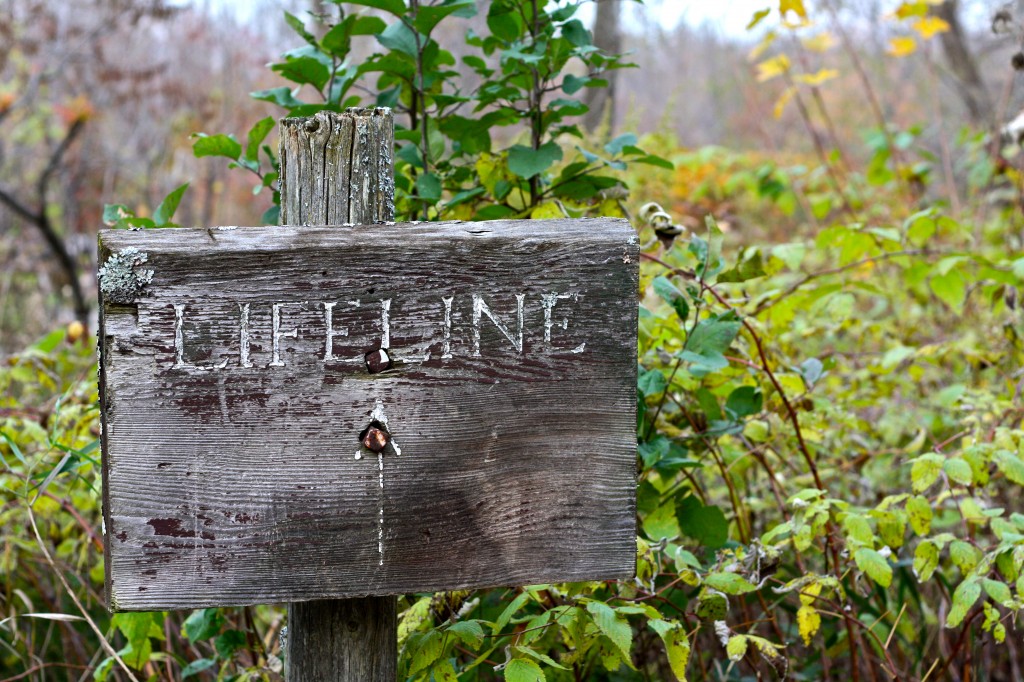 Ten years ago I was lost. I had just returned to work after my fourth and final maternity leave, and I was completely miserable. Not only was it hard to leave my baby every day, but I was in a job that didn’t sustain or inspire me. All it did was drain my energy every single day. In those days, it wasn’t unusual for tears to flow on the way home from work.
Ten years ago I was lost. I had just returned to work after my fourth and final maternity leave, and I was completely miserable. Not only was it hard to leave my baby every day, but I was in a job that didn’t sustain or inspire me. All it did was drain my energy every single day. In those days, it wasn’t unusual for tears to flow on the way home from work.
Five years earlier, I’d taken my first leadership job in the government and I took to it like a duck to water. I loved the challenge and I loved my team. I was inspired and energized by the opportunity to provide them guidance and unleash their creative potential. I had an eager and talented young staff and we worked together beautifully, finding creative ways to communicate and commemorate the sacrifices our veterans had made.
At the start, it was good, but then things started to go wrong. For one thing, I started to internalize some of the messaging I was hearing at leadership workshops and from leadership mentors. “Keep your feelings out of leadership.” “It’s about control and moderation, not about passion.” “Don’t let them see you vulnerable.” “Use your head and ignore your heart.”
For another thing, I stepped away from that first job to take one that offered higher pay and more security. Unfortunately, it was all wrong for me and the environment was toxic. It was a science environment where most of the leaders were in their roles because of their knowledge of science rather than their leadership abilities or their understanding of people. As a professional communicator, I was usually the only one at the management team table who didn’t have an advanced science degree. In an environment that valued left-brain logical thinking, there was little space for my right-brain, intuitive, heart-based approach to leadership.
I felt lost – like a foreigner in a foreign land. If this was what leadership entailed, I wasn’t sure I wanted to be a leader anymore.
And then one day, I started to explore a new way of looking at leadership (that was much closer to the way I’d intuitively lead when I’d first started) and it felt like someone had offered me a lifeline. I can’t remember whose work I discovered first, but three writers started to show up on my radar screen – Christina Baldwin, David Irvine, and Margaret Wheatley. All three wrote about authentic, community-based, vulnerable leadership. They inspired me to lead from a place in the circle, live simply in a complex world, and turn to one another. (I am deeply grateful that in the years since then, I’ve had the opportunity to attend workshops with all three of these incredible teachers.)
Not long after that, I left the government for non-profit. It was a job I loved, but it was also one that challenged me in more ways than I’d ever been challenged before. Every leadership ability that I thought I’d gained and every principle I thought I valued was put to the test. I led a national team that was mostly full of fiercely independent people who didn’t really want to be lead. I was emotionally abused, I had a lawsuit filed against me by someone who felt she was wrongfully dismissed, I witnessed more than one emotional breakdown among my staff, and I had to deal with multiple conflicts and miscommunications between staff. It was a good place to work, but it was hard and I often felt very much alone. I was floundering and there was nobody to talk to about it. I searched for a circle of other leaders who might serve as my support system, but I found none. The best I could do was have regular coffee dates with my friend Susan who understood my challenges and was always a good listening ear.
When I finally left that job to become self-employed, I knew that one of the things I wanted to do was to serve women like me who knew they had a calling to be in leadership in some form or another (whether at the boardroom table or the kitchen table) and needed someone to support and guide them. I tried to do that from the beginning, and I briefly offered a program called “How to Lead with Your Paint Clothes On”, but there was something holding me back that I had to work through first.
The truth is, there were some failure stories that were getting in the way of my calling to support other emerging leaders. There was the story of my last year at the non-profit, when I was so burnt out that I was mostly ineffectual as a leader. There was the story of the ugliness of the lawsuit (that was never resolved, by the way), and the difficulties surrounding that relationship. There was the story of the pseudo-coach who’d blasted me for my unprofessionalism when I responded emotionally to a staff member’s suicide threat. There was the story of the many attempts I’d made to build a unified team out of independently-working people spread across the country.
Every time I’d think about offering a leadership program for women emerging into leadership, I’d get blocked by the gremlins that told me “you failed at leadership – what gives you the audacity to think you could teach people?”
And yet, the memory of the lifeline I’d been offered in my most lost place kept propelling me forward. I knew that the woman I was ten years ago desperately needed women like me to serve as her guide – women who’d been through the challenges, admitted her failures, had a few glorious moments, and learned from her mistakes. I knew that she needed someone who would encourage her without judging her. I knew she needed to be given permission to lead with her heart and not just her head. I knew – more than anything – that she needed someone to say “You’re okay. You’re enough. You’re on the right path. Don’t give up.”
This summer, I had the privilege of co-hosting a beautiful circle of 44 women at the annual Gather the Women gathering, and I walked away inspired once again by the need this world has for more women to gather in circle and offer their hearts into the service of transformation. After asking the women to share stories of courage, I knew that the most courageous thing I could do would be to more boldly and confidently step into the role of guide for women emerging into leadership.
Finally, after two years of self-employment, I am ready to offer the thing that’s been tugging at my heart for years – a personal leadership program for women emerging as changemakers, artists, visionaries, storytellers, and edgewalkers.
It’s called Lead with your Wild Heart, and it comes directly from my wild heart to yours.
First and foremost, it’s about redefining leadership. I believe what Margaret Wheatley says, that “a leader is anyone who is willing to help, anyone who sees something that needs to change and takes the first step to influence that situation.”
This program is for you if you’re imagining a better future for yourself, your community, or the world. It’s for you if you feel something nudging you to step into your courage. It’s for you if you’re the lost young woman I was, stuck in a corporate world that’s eating away at your soul. It’s for you if you’ve been wounded by a patriarchal model of leadership and you need healing and encouragement. It’s for you if you need permission to follow your heart. It’s for you if you’ve been longing for a program that honours ALL of who you are – body, mind, and spirit.
I offer this humbly, admitting that I have made mistakes and that I still have much to learn in my journey. Because I still have much to learn, I have invited a number of wise, wild-hearted friends to share their stories and wisdom with the participants of the program as well. I’m honoured that a long list of willing guides (including some people who’ve been my own teachers) have stepped forward and agreed to have conversations with me that will be recorded and made available as part of the program. Follow the link to find out more.
I hope that you’ll consider joining me and/or share this with other women you know who might need it.
by Heather Plett | Oct 4, 2012 | Beauty, beginnings, Community, Creativity, fearless, hope, journey, Leadership
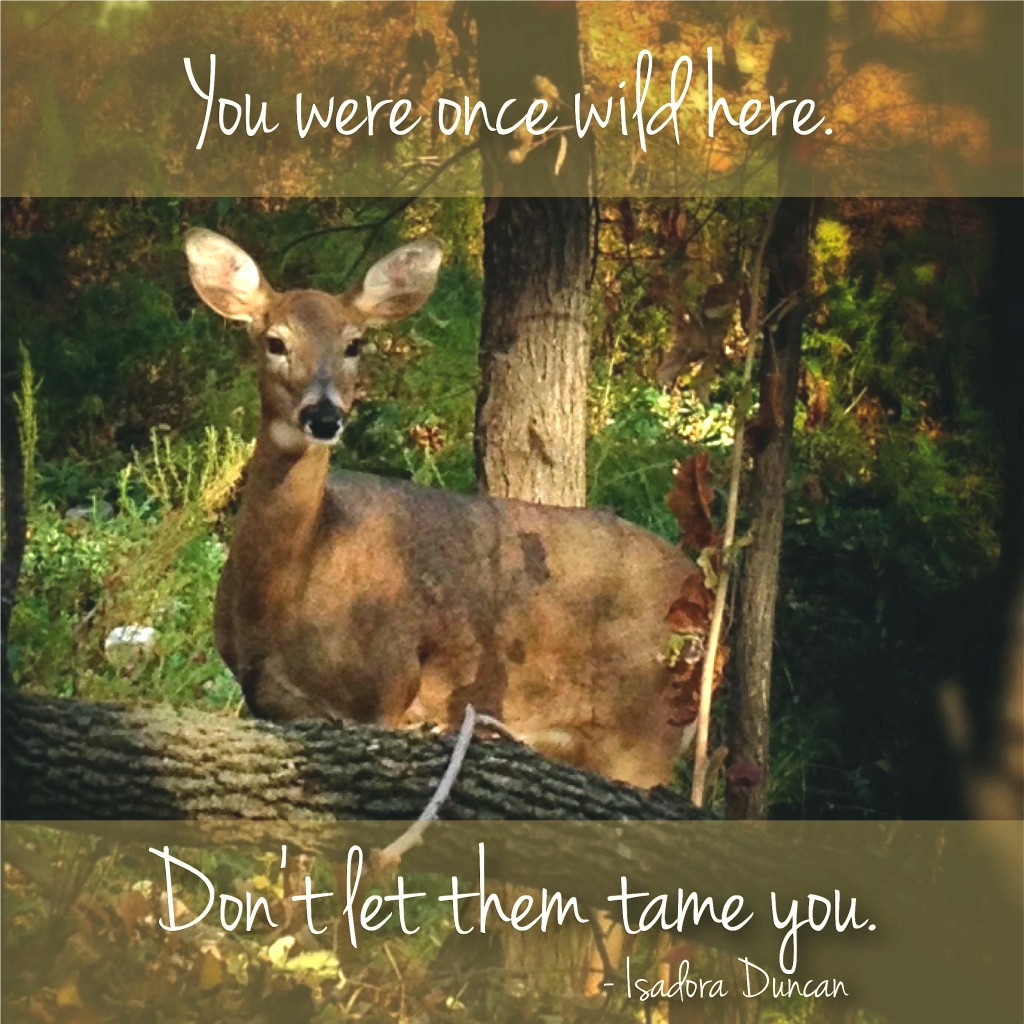 I have seen too many wounded women.
I have seen too many wounded women.
I have watched them lose the light in their eyes when the shadows overcame them.
I have heard a thousand reasons why they no longer give themselves permission to live truthfully.
I have seen too many wild hearts tamed.
I have witnessed the loss of courage when it’s just too hard to keep being an edgewalker in a world that values conformists.
I’ve recognized the fear as they take tiny brave steps, hoping and praying the direction is right.
“I feel guilty whenever I indulge in my passions. It feels selfish and irresponsible.”
“My husband doesn’t like it when I talk about feminine wisdom, so I keep it to myself.”
“If I write the things that are burning in my heart, it will freak people out. So I remain silent.”
“I used to love wandering in the woods, but I never have time for it anymore.”
“I just want to have a real conversation for a change. I want to feel safe to speak my heart.”
“My job makes me feel dead inside, but I don’t know what else I can do.”
“People expect me to be strong and hide my feelings now that I’m in leadership. I feel like I have too much bottled up inside that I can’t share with anyone.”
“Sometimes I think there must be something wrong with me. I just don’t fit in.”
“There is so much longing in the world. I get lost in that longing and don’t know how to sit with it.”
“I wanted to be a painter, but I needed a real career. I haven’t painted in years.”
“People think I’m strange when I share my ideas, so I’ve learned to keep them to myself.”
“I can’t go to church anymore. I don’t feel understood there. But I haven’t found another place where I can find community, so I often feel lonely.”
“There’s a restless energy inside me that wants to be free. I long to be free.”
So much woundedness has been laid tenderly on the ground at my feet.
So many women want their stories validated. Their fears held gently. Their tiny bits of courage honoured.
I hear them whisper “please hear me” through clenched teeth.
I see the tears threaten to overflow out of stoic eyes.
I recognize the longing.
I know the brokenness.
I feel the ache of silenced dreams.
They come to me because they know I have been broken too.
They trust me with their whispers because I am acquainted with fear.
They look to me for courage and understanding because they witness my own long and painful journey back to my wild heart.
I see you.
I know you.
I honour you.
I love you.
You are beautiful.
You are courageous.
You are okay.
You can be wild again.
You can trust your heart. She will not lie to you.
You can live more fully in your body. She will welcome you back.
You can go home to that part of you that feels like it’s been lost.
You can find a circle of people who will understand you.
You can step back into courage.
You have permission to be an edgewalker.
You have permission to speak the things that you’re longing to say.
You have permission to be truly yourself.
You have permission to step away from your responsibilities for awhile.
You have permission to wander in the woods.
You also have permission to be afraid.
And to wait for the right time.
And to sit quietly while you build up your courage.
You don’t need to do this all alone.
And you don’t need to do it all at once.
You don’t need to shout before you’re ready to whisper.
You don’t need to dance before you’ve tried simply swaying to the music.
You can give your woundedness time to heal.
Take a small step back into your self.
Move a little closer to your wild heart.
Pause and touch the wounded places in you.
Just breathe… slowly and deeply.
And when you’re ready, we can do this together.
If this post resonates, please consider the following:
1. Join me as I host a circle of amazing women at A Day Retreat for Women of Courage in Winnipeg on October 20th. Pay what you can.
2. I’m creating a new online program called Lead with Your Wild Heart (related to the themes in this post) that feels like a coming together of a thousand ideas that have filled my head in recent years. Add your name to my email list (top right) to be the first to hear about it and to receive a discount.
by Heather Plett | Sep 24, 2012 | journey, practice
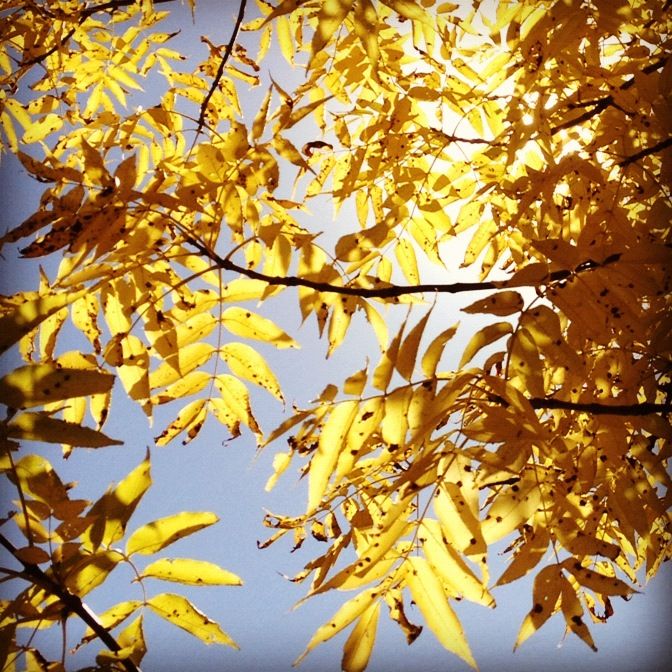
Yesterday, Ronna Detrick and I (and the women who’d gathered in circle with us) had a heart-opening conversation about pilgrimage, community, story-telling, and feminine spirituality. (You can listen to the recording here.) I love having conversations like this because, even if I’m the one doing the teaching, I always end up walking away with more clarity than I had before.
At the end of the call, after I’d shared several stories of the “hardships, darkness, and peril” along my own pilgrimage, Ronna asked me to talk about how I hang onto hope in the middle of the dark times.
It’s a timely question for me, and it’s been on my mind since our conversation. As much for myself as for you, the following are some reminders of how to reach for hope when life knocks us off our feet.
1.) Find community. I can’t stress this strongly enough. You NEED community. You need a circle of people who will support you and who won’t judge you when you’re falling apart. You need to let yourself be held when you’re not feeling strong enough to walk on your own. There is no weakness in admitting that you need other people.
2.) Find wild spaces to wander in. When I’m falling apart and hardly know how to articulate the depths of the pain, I head to the woods or the riverbank. I find the Goddess there, in the most unexpected ways – in the wind, in the waves on the river, in the twinkling light reflected off the water, in the eyes of the deer who stands and stares at me. I think the Goddess is especially comfortable showing up in wild spaces because she has a wild heart herself. I feel comforted and more alive when I step out of the woods and return to my hope.
3.) Rest. It’s always important to rest, but when you’re going through especially difficult times, you need to find even more rest than usual. Deep, soulful rest that replenishes your strength. Take naps and hot baths, curl up with a good book, let people do some of your chores for you – just rest.
4.) Give yourself permission to cry. A social worker once told me that tears are the window-washers of the soul. It might sound a little corny, but it’s true. The tears help clean us and they help improve our vision. Let those deep sobs erupt from your belly and don’t try to keep them inside. Tears held in for too long will drown you.
5.) Find spiritual practices that sustain you. I’ve said this many times and I’ll say it again – spiritual practices are especially necessary when your pilgrimage gets difficult. Your spiritual practice can be as unique as you are – dancing, singing, walking, painting, praying, meditating, yoga, or photography. These practices shift us out of our left-brain thought processes that want to fix our problems or find logic in them or rush through them to the next easy place on the journey. Inside the practice, we rest in the unknowing space, where the problems serve as our teachers rather than our adversaries.
by Heather Plett | Sep 22, 2012 | journey, Labyrinth
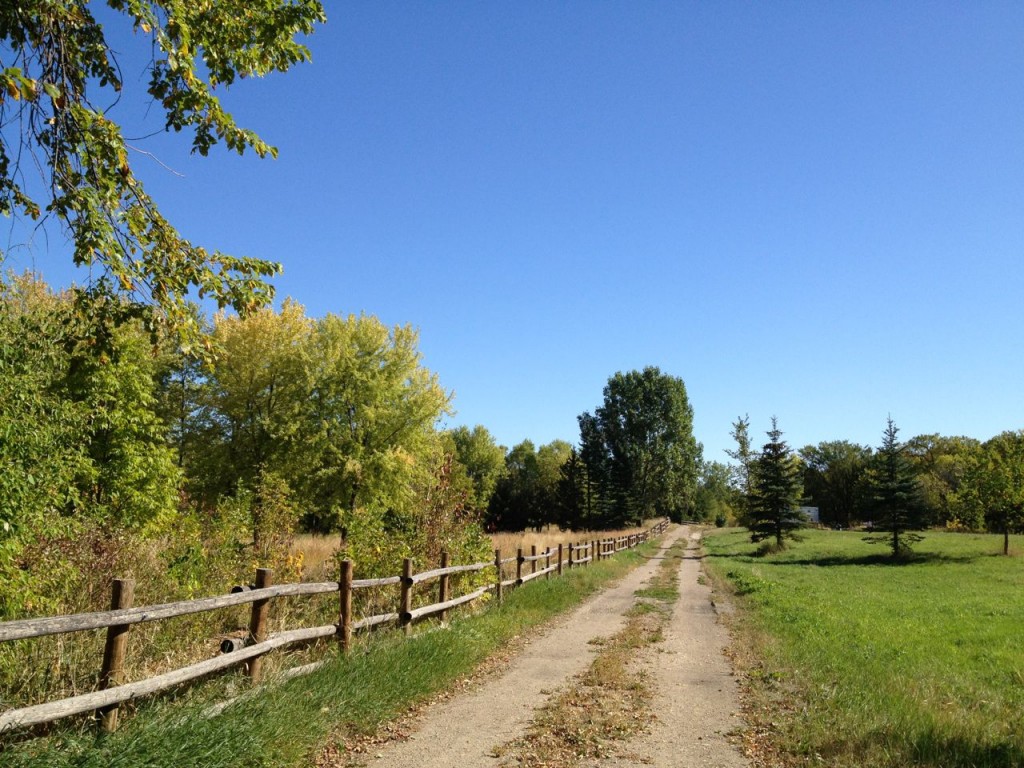
This story has no clear beginning and no clear ending. It’s a pilgrimage story, and without going all the way back to the beginning of my life (and even the lives that were lived before mine that thread through mine), or waiting until I’m ready to die, I can only tell you about a small portion of that pilgrimage.
This week I’ve been revisiting my memoir, hoping to bring it to completion and eventually get it published. I set it aside months ago, thinking it was almost finished, but feeling like I might still be missing a piece of the puzzle.
I think I’ve found that puzzle piece. It started with adding the above words to the beginning. The story is now a pilgrimage story, with no clear beginning and no clear ending.
It used to be simpler. The very first time I tried to write it, it was about the three week period in the hospital waiting for Matthew to be born, and how that impacted me in a deeply spiritual way. The second time I wrote it, it was about a ten year transformation in my life, starting with the arrival of Matthew in my life. I was comparing myself to a caterpillar, going into a cocoon for ten years and eventually emerging as a butterfly. Or Theseus, heading into the labyrinth holding the thread, slaying the minotaur, and emerging victorious. And they all lived happily ever after. The end.
But now, after months of contemplation, I know that it’s not that straight-forward. Transformation is not a clean and simple thing that we can put into time frames or boxes. I’m still transforming. I’m still being stretched. I’m still not a butterfly. I’m heading back into that labyrinth again and again.
And so I am more satisfied calling my journey a pilgrimage. My son’s death was one of a long series of initiations, each one taking me deeper and deeper into my own heart. Each one teaching me how little I actually know. Each one revealing something new about God.
Now I am at a new place in the journey. In past initiations on this pilgrimage, I have lost my innocence, lost a son, lost a father, nearly lost a husband more than once, lost a father-in-law, and lost all of my grandparents. (Incidentally, nearly all of those things happened around this time of year.) I have fought the minotaur many times and returned from the labyrinth scarred and yet stronger. I expect my next initiation will be to learn what it’s like to lose a mother.
My responsibility as a pilgrim is simply to put one foot in front of the other and keep following the path. When the labyrinths appear along the path, I need to trust that a sword and a thread will be provided to help me survive.
If you’re interested in being part of a conversation about life as pilgrimage, join me tomorrow morning as I talk to my friend Ronna Detrick on her virtual Sunday Service at 10 am PST.
Most of us arrive at a sense of self and vocation only after a long journey through alien lands. But this journey bears no resemblance to the trouble-free ‘travel packages’ sold by the tourism industry. It is more akin to the ancient tradition of pilgrimage – ‘a transformative journey to a sacred center’ full of hardships, darkness, and peril. – Parker Palmer, Let your Life Speak
by Heather Plett | Aug 28, 2012 | calling, circle, Community, family, journey, prayer, Trust, women
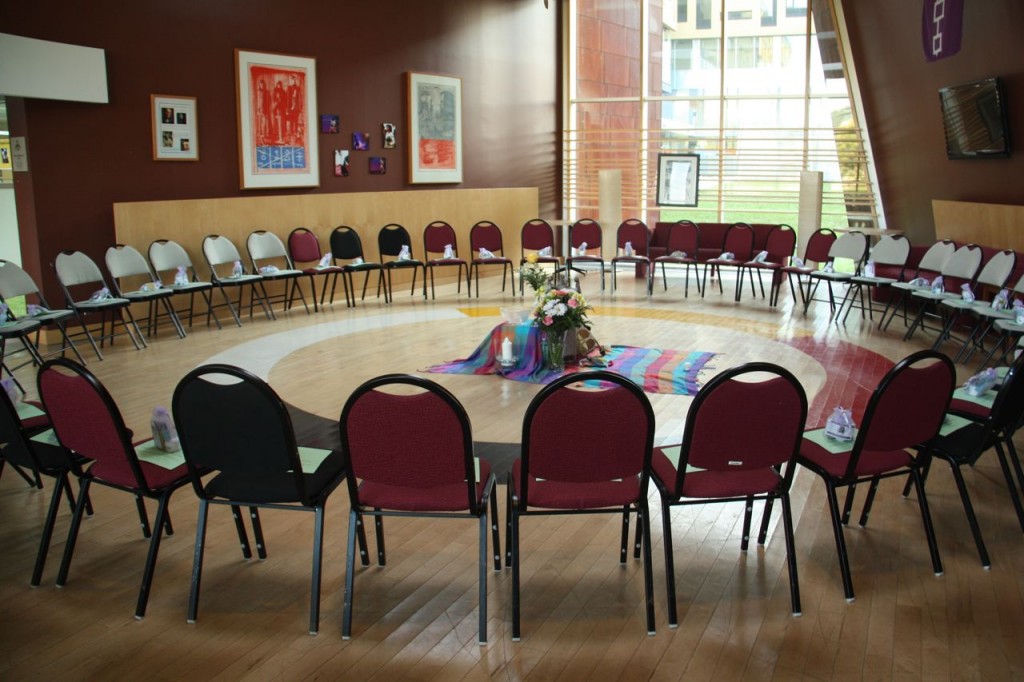 It seems appropriate and metaphorical that my journey to the Gather the Women event I was co-hosting was a long and arduous journey, and yet filled with moments of beauty and grace. The thirty-five hours I’d planned to spend on a train turned into forty-five and a half. I’d looked forward to the many hours of reading, writing, contemplation, and staring out the window (especially after the hard week before), but there’s only so much of that a person can take before the body begins to complain.
It seems appropriate and metaphorical that my journey to the Gather the Women event I was co-hosting was a long and arduous journey, and yet filled with moments of beauty and grace. The thirty-five hours I’d planned to spend on a train turned into forty-five and a half. I’d looked forward to the many hours of reading, writing, contemplation, and staring out the window (especially after the hard week before), but there’s only so much of that a person can take before the body begins to complain.
The moments, though, when I watched a moose run across a pond, or a great blue heron flap its mighty wings as it lifted itself out of the water, or a perfect circle of sunlight streaming out of a dark cloud, made the difficult journey bearable.
When I finally arrived in Peterborough, along with the other three members of the planning committee, I was weary but excited for what the next four days would bring. Forty-five women were gathering from across North America to sit in circle, share stories, and honour their feminine wisdom. I felt incredibly humbled to have the opportunity to host such a gathering. (Side note: I just realized that there was one woman for every hour I spent on the train! That thought makes me smile.)
The night before the gathering was to begin, I got bad news that almost convinced me to return home. The results of my Mom’s CT scan had come back. It was confirmed that the cancer she’d been treated for over the past year was still growing in her abdomen. Grief swept in and encompassed me. I didn’t know how I would make it through the rest of the week and do the job I needed to do.
I shared the news with the planning committee, and they surrounded me with love and community. “Go home if you need to,” they said. “We’ve got your back.”
The next morning, I decided I’d stay. Something told me that being part of this circle of women would help me have the courage to return home to what I needed to face.
It wasn’t easy. The details of gathering – putting together registration packets and gift bags, writing flip charts, and cutting string for my creative workshop – felt so trivial in light of what I was dealing with. At the same time, though, creating a space of comfort and inspiration for the women who were traveling many miles (literally and metaphorically) to be there was not trivial at all.
Before the opening circle began, I stepped into the room where creative women were preparing to sell their art in a small marketplace. Near the entrance was the beautiful art of Maia Heissler. She was in the midst of hanging her beautiful Forest Friends on a small hand-made tree when I stopped to chat with her.
“I’ve created these specially for the gathering,” she said. “They tell the stories of women gathering. This one is of a woman celebrating, surrounded by the women who love her. This one is of a woman who’s been dealt a basket of sorrows. Her community of women are helping her bear the burden.”
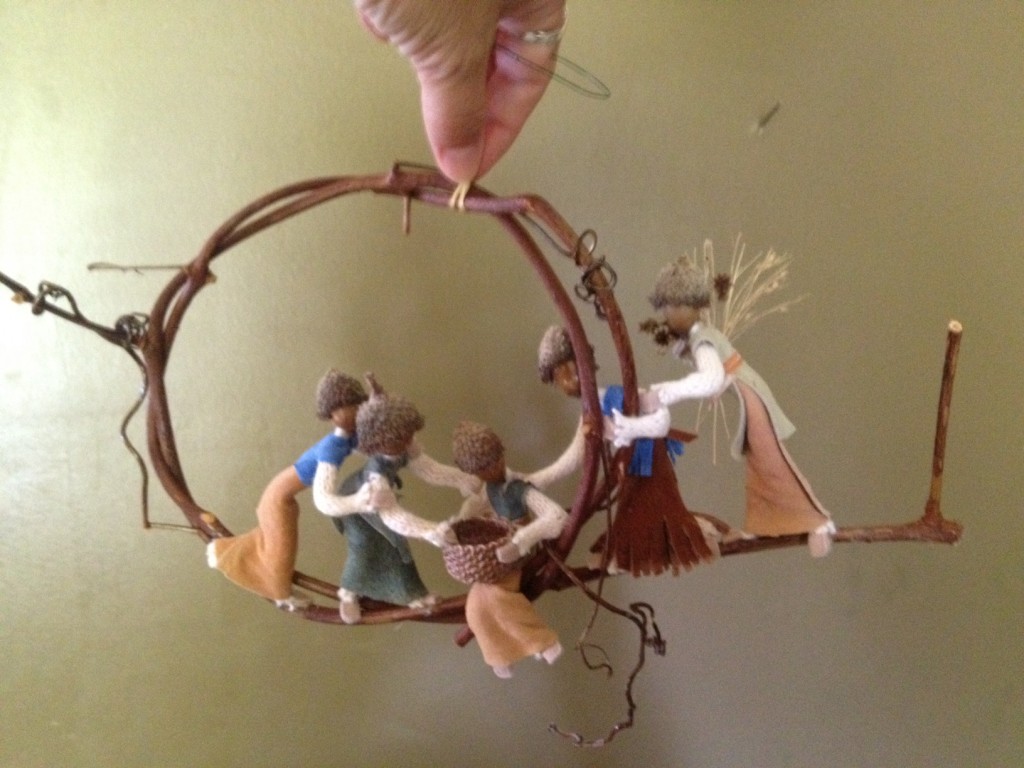
“That one,” I said. “I think I need to go home with that one. I AM that woman with the basket of sorrows.” I didn’t tell her what was in my basket, but I asked her to hold the piece until I’d decided whether I could afford to buy it.
On Thursday evening, there was levity and celebration in the opening celebration. I could hardly bear to be in the room. I spent most of the evening lying on my bed, alone in my room. I emerged only periodically to hear some of the stories that were being shared. Another woman shared how she, too, had taken the train and been subjected to lengthy delays.
Friday morning’s opening circle was beautiful and powerful. One by one we shared stories of how we’d come to be in this circle. Each of us placed a meaningful object in the centre of the circle and then added water we’d brought from our various homes into a collective bowl. When it came my turn to share, I added water that I’d brought from the graveyard where my son Matthew is buried and said that it felt like I was carrying a vial of tears with me. I said nothing about my mom. Something told me to hold that story close for the time being.
In the afternoon, I lead a workshop on storytelling, courage, and community. The women were invited to break into small circles of three to share stories of times in their lives when they’d had courage and times in their future when courage would be required of them. Out of those stories, they chose words and phrases to put onto prayer flags to take home and remind themselves of how the community supports their courage.
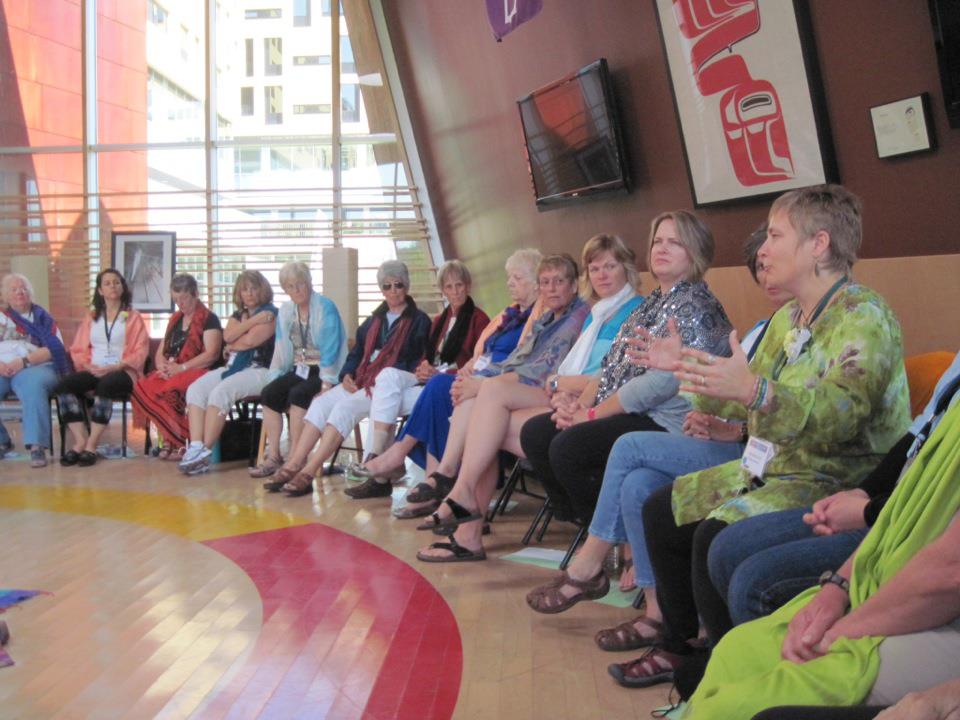
I didn’t participate in the story-sharing. Instead, I walked around with my camera, taking pictures of the beautiful faces as they softened and grew more vulnerable within the safe circles of trust.
Before the weekend ended, I bought the art piece of the woman with the basket of sorrows. Though it felt like more money than I could justify spending on myself, I knew I needed to take it home with me.
As the weekend progressed, I found my spirits lightening despite the heaviness in my chest. I was able to celebrate and dance and sing around the campfire. On Saturday afternoon, together with my delightful and spontaneous friend and mentor Diane, I went swimming in my clothes in the river that runs through the centre of Trent University. We convinced our new young friend Lindsay to join us. It was a lovely moment of lightness and joy.
As we drew nearer to the closing circle on Sunday morning, I contemplated whether or not to share the story of my Mom with the circle. I was a little conflicted. As one of the hosts of the gathering, I was somewhat reluctant to draw too much attention to myself, and yet as a member of the circle, it didn’t feel right to leave the circle without entrusting them with my pain. The beauty of the circle is that we all hold equal positions and one’s pain or joy is as important as another’s.
Just before the closing circle, one of the women with whom I hadn’t spoken much approached me. “You are a gifted woman, and you give so much to the group,” she said. “And yet there’s a sadness in your eyes. I want to honour whatever it is that gives you sadness.” At that moment, I knew I needed to share.
It took quite awhile for the talking piece to make its way to me. As it traveled, I listened deeply to the stories that were shared. So many women were going home with renewed courage and hope and strength after being part of the circle. It was a beautiful thing to behold.
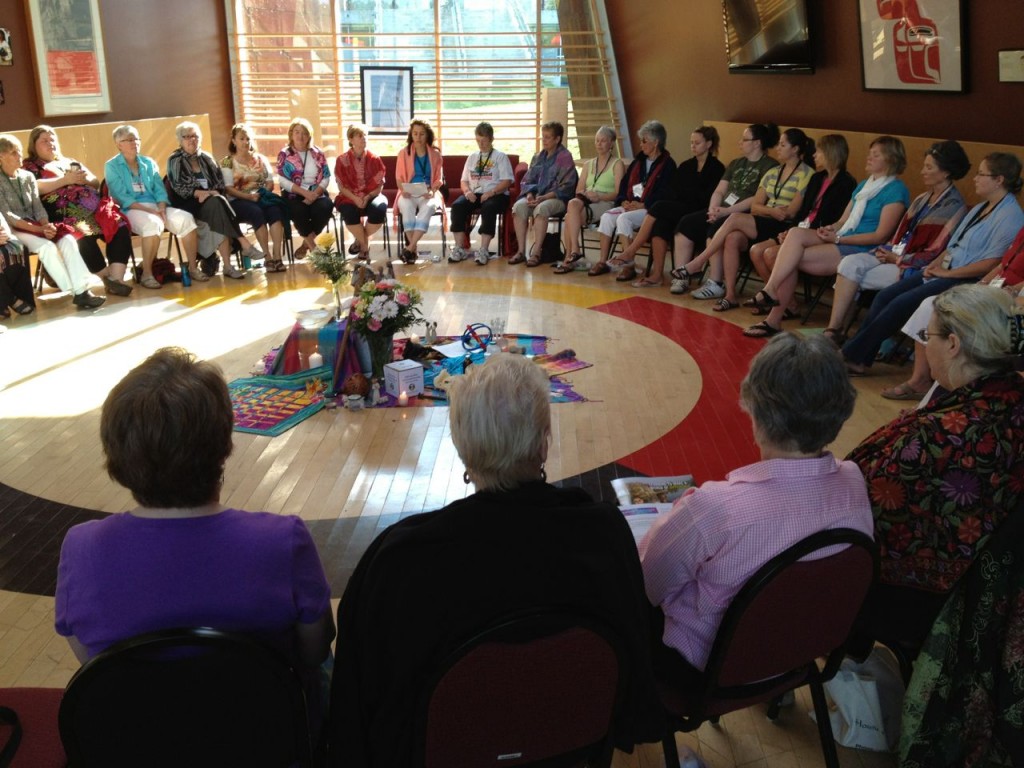
When it came my turn, I began by saying that I felt like I’d just been held in the arms of the Great Mother. “I am conflicted,” I said. “It is always so exciting for me to come to an event like this, because I know that this is my calling – to be in places like this, and to teach more people about storytelling, circles, courage, and community. I want to go home and do big things – teach, write and speak. And yet I have received a new calling this weekend – one that I am much more reluctant to follow.”
And then I shared the news I’d gotten – that my own mother might not be with me much longer. “My calling now,” I said, “is not to do big things, but to do small things – to sit in circle with my mother and be with her as she journeys toward the end of her life here with us.”
I held my water vial up and said “before we meet again, there will be many more tears in this vial.” I looked around the room and saw that nearly every woman in the circle had tears in her eyes. My pain had become their pain.
What an incredibly moving thing it is to know that you don’t cry alone! I am surrounded, in that circle and in the circles I returned to when I came back home, with so much love and community.
Yes, I am a woman who has been dealt a basket of sorrows (as is my mom, my sister, my mom’s sister, my sisters-in-law, and the other women who surround my mom – and of course there are many men in that circle too), but I know that I don’t have to carry it alone, and for that I am immensely grateful.
On Monday, the day after Gather the Women ended, my sister and I went to see the oncologist with my Mom and her husband. There we were told that Mom may be with us for six months or more, but probably less than a year. She has the option of taking more chemo treatments, but that will merely prolong her life somewhat and not stop the growth of the cancer. In the coming months, we need to prepare for her journey into the next life.
I didn’t take the train home on the return trip, and yet I know that there is a long and arduous journey ahead of me in the coming months. I also know that that journey will have intermittent moments of peace, beauty, and grace, just like my train ride did.
This I know – we are surrounded by love and we are held in the arms of the Great Mother/Father. May I continue to trust in that.
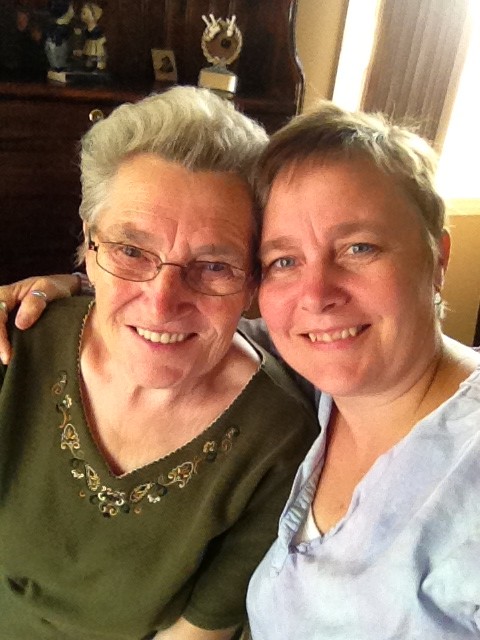
Mom and me










